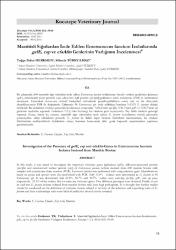Mastitisli Sığırlardan İzole Edilen Enterococcus faecium İzolatlarında gelE, esp ve efaAfm Genlerinin Varlığının İncelenmesi
Abstract
Bu çalışmada, 600 mastitisli sığır sütünden izole edilen Enterococcus faecium izolatlarının önemli virülens genlerinin [jelatinaz
(gelE), enterokokal yüzey proteini (esp), adezyonla ilgili protein (efaAfm)] polimeraz zincir reaksiyonu (PZR) ile incelenmesi
amaçlandı. Enterokok izolasyonu selektif besiyerleri kullanılarak gerçekleştirildikten sonra cins ve tür düzeyinde
identifikasyonlar PZR ile doğrulandı. Çalışmada 96 Enterococcus spp. izole edilirken; bunların %13,5’i E. faecium olduğu
belirlendi. Bu izolatların virulens genlerinin incelenmesi sonucunda %69,2’sinin efaAfm, %30,7’sinin gelE ve %30,7’sinin esp
genlerini taşıdıkları saptandı. İzolatların %23,1’inin herhangi bir virulens geni taşımıyordu. Beş farklı virulens genotipi
saptandı. Sonuç olarak bu çalışma, mastitisli sığır sütlerinden izole edilen E. faecium izolatlarının yüksek patojenite
potansiyeline sahip olduklarını gösterdi. E. faecium ile ilişkili diğer virulens faktörlerin tanımlanması, bu virulens
faktörlerinin antibiyotiklerle ilişkilerinin ortaya konması konusunda daha geniş kapsamlı araştırmaların yapılması
gerekmektedir. In this study, it was aimed to investigate the important virulence genes [gelatinase (gelE), adhesion-associated protein
(efaAfm) and enterococcal surface protein (esp)] of Enterococcus faecium isolates isolated from 600 mastitic bovine milk
samples with polymerase chain reaction (PCR). Enterococci isolation was performed with using selective agars. Identifications
based on genus and species were also performed with PCR. Only 13.5% isolates were determined as E. faecium in 96
Enterococcus spp. It was determined that 69.2%, 30.7% and 30.7% isolate were carrying efaAfm, gelE, and esp genes,
respectively. 23.1% of the isolates did not carry any virulence genes. Five different genotypes were detected. Finally, it can
be said that E. faecium isolates isolated from mastitic bovine milk have high pathogenity. It is thought that further studies
should be conducted on the definition of virulence factors related to severity of the infection and expending traits of E.
faecium and their relationships with some kind of antibiotics should also be revealed.
Source
Afyon Kocatepe Üniversitesi, Kocatepe Veteriner DergisiVolume
9Issue
2URI
http://kvj.aku.edu.tr/wp-content/uploads/sites/56/2016/06/2016_9_2_Article_1.pdfhttp://hdl.handle.net/11630/4321
Collections
- Cilt 9: Sayı 2 [12]



















